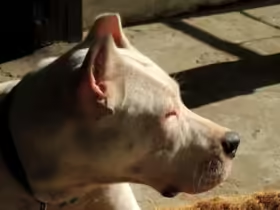Introduction
Foxtails may seem like harmless plants, but for dogs, they pose serious risks. These grassy weeds have barbed seeds that can easily attach to a dog’s fur and burrow into their skin, causing a range of health issues, from mild discomfort to severe infections. Understanding the dangers of foxtails and knowing how to protect your dog is crucial for every pet owner.
What Are Foxtails?
Foxtails are grasses that produce seeds resembling a fox’s tail, hence the name. These plants are most commonly found in North America, particularly in dry and grassy areas. The barbed seeds are designed to burrow into the soil, but unfortunately, they can also burrow into a dog’s skin, nose, ears, eyes, and even internal organs if ingested or inhaled.
Why Are Foxtails Dangerous for Dogs?
Foxtails are dangerous due to their sharp, pointed shape and barbed design. Once they attach to a dog’s fur, they can easily penetrate the skin and migrate through the body, causing various complications:
- Skin Irritation and Infections: Foxtails can embed in a dog’s skin, leading to painful abscesses and infections.
- Respiratory Issues: If inhaled, foxtails can lodge in the nasal passages, throat, or lungs, causing coughing, difficulty breathing, and potentially life-threatening infections.
- Eye and Ear Injuries: Foxtails can get lodged in a dog’s eyes or ears, leading to severe pain, inflammation, and even permanent damage if not treated promptly.
- Internal Damage: Ingested foxtails can travel through the digestive system, causing internal injuries, blockages, or infections.
Common Symptoms of Foxtail Exposure
Recognizing the signs of foxtail exposure is essential for early intervention. Some common symptoms include:
- Excessive Licking or Chewing: If a foxtail has embedded in your dog’s skin, they may lick or chew the affected area excessively.
- Redness, Swelling, or Discharge: Infected areas may become red, swollen, and produce pus or other discharge.
- Persistent Sneezing or Coughing: If a foxtail has entered the nasal passages or throat, your dog may sneeze or cough repeatedly.
- Squinting, Tearing, or Pawing at the Eyes: These signs may indicate that a foxtail is lodged in the eye.
- Head Shaking or Ear Scratching: Foxtails in the ears can cause discomfort, leading to excessive head shaking or scratching.
- Lethargy or Loss of Appetite: Ingested foxtails or severe infections can cause your dog to feel unwell, leading to decreased energy and appetite.
How to Check Your Dog for Foxtails
Regularly checking your dog for foxtails can help prevent serious health issues. After outdoor activities, especially in areas where foxtails are common, inspect your dog’s:
- Fur: Run your hands through your dog’s fur, paying special attention to areas where foxtails are likely to get caught, such as between the toes, under the tail, and around the ears and neck.
- Paws: Check between your dog’s toes and around their paw pads for any signs of foxtails.
- Ears: Look inside your dog’s ears for any foxtails or debris.
- Eyes: Inspect your dog’s eyes for any foreign objects or signs of irritation.
- Nose and Mouth: Be on the lookout for any unusual behavior, such as sneezing or coughing, that could indicate a foxtail has entered the nasal passages or mouth.
Prevention Tips
Prevention is key to protecting your dog from the dangers of foxtails. Here are some practical tips:
- Avoid Foxtail-Infested Areas: During the foxtail season (usually late spring to early fall), avoid areas where these plants are prevalent, such as dry, grassy fields.
- Keep Your Dog on a Leash: When walking in areas where foxtails are present, keeping your dog on a leash can prevent them from running through dense vegetation.
- Regular Grooming: Regularly groom your dog, especially if they have long or thick fur, to remove any foxtails that may have attached to their coat.
- Protective Clothing: Consider using protective clothing, such as dog boots or vests, to reduce the risk of foxtails attaching to your dog’s fur.
- Lawn Maintenance: If you have foxtails growing in your yard, remove them to minimize the risk to your dog.
What to Do If Your Dog Encounters a Foxtail
If you suspect that your dog has been exposed to a foxtail, take immediate action:
- Remove the Foxtail: If the foxtail is visible and easily accessible, carefully remove it using tweezers. Be gentle to avoid pushing it deeper into the skin.
- Monitor for Symptoms: Even if you remove the foxtail, monitor your dog for any signs of infection or discomfort.
- Visit the Vet: If the foxtail has penetrated the skin, or if your dog is showing symptoms such as persistent sneezing, coughing, or swelling, seek veterinary care immediately. Your vet may need to remove the foxtail surgically or prescribe antibiotics to treat any infections.
Treatment Options
If your dog requires veterinary care due to foxtail exposure, treatment options may include:
- Physical Examination: The vet will examine your dog to locate the foxtail and assess any damage.
- Imaging: X-rays or ultrasounds may be used to locate deeply embedded foxtails, especially if they have migrated internally.
- Surgical Removal: If the foxtail has penetrated deeply, surgical removal may be necessary.
- Antibiotics and Pain Relief: In cases of infection or severe discomfort, your vet may prescribe antibiotics and pain relief medication to aid in recovery.
Long-Term Effects of Foxtail Exposure
While many foxtail-related injuries can be treated successfully, some cases may result in long-term complications, such as:
- Chronic Infections: If a foxtail is not removed promptly, it can lead to chronic infections that require ongoing treatment.
- Permanent Damage: In severe cases, foxtails can cause permanent damage to the eyes, ears, or internal organs.
- Surgical Scarring: Surgical removal of deeply embedded foxtails may result in scarring or the need for multiple procedures.
Conclusion
Foxtails may be small, but they can cause significant harm to your dog. By understanding the dangers, recognizing the symptoms, and taking preventive measures, you can protect your furry friend from the risks posed by these invasive plants. Regularly check your dog after outdoor activities, avoid foxtail-infested areas, and seek veterinary care if you suspect foxtail exposure. Your vigilance can make all the difference in keeping your dog safe and healthy.











Leave a Reply